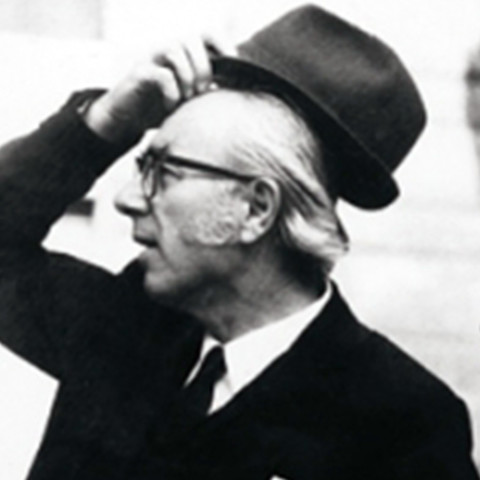This article was published in Australian Dictionary of Biography, Volume 17, (MUP), 2007
Richard Haughton (Jimmy) James, designer, advertising executive and painter, was born on 22 August 1906 at West Grinstead, Sussex, England, son of Montague Gifford James, a major in the Indian Army soon to become an Anglican clergyman, and his wife Violet, née Royston-Pigott.
Educated at Denstone College, Staffordshire, James intentionally failed a university entrance examination and went to London to become a cartoonist with the Daily Graphic and later a commercial artist at Grafton Art. By 21 he was studio manager of a design company and had launched his own advertising school. On 26 July 1930 at the parish church, Kensington, he married Dorothy (‘Terry’) Charlotte Stephens; they had one son.
In the 1930s James held senior positions with the small agency Erwin Wasey and the international McCann-Erikson. When unemployed because of mergers or company failures, he turned his hand to designing book jackets, sports clothes and even perfume bottles for Schiaparelli. He wrote and drew ‘Our Nellie’, a comic strip for the Sunday Express, and became interested in easel painting. In an attempt to save their marriage, the Jameses decided in 1938 to migrate to Australia. They arrived in Sydney in February 1939 after nearly six months in Tahiti, a period to which he would ever more refer.
Appointed senior creative director with J. Walter Thompson Australia Pty Ltd — the nation’s biggest advertising agency –James soon established himself in the artistic life of the city. A fellow of the Royal Society of Artists, he founded the Design Centre with Geoff and Dahl Collings, wrote for Sydney Ure Smith’s Australia: National Journal and gave weekly radio broadcasts and frequent lunchtime lectures. He vigorously defended the work of the Contemporary Art Society and joined Ure Smith in launching the Design and Industries Association of Australia in 1940. In 1944 he appeared as a witness for (Sir) William Dobell in the Supreme Court case initiated to overturn his winning of the Archibald prize.
Having enlisted in the Militia on 28 October 1942, James transferred to the Australian Imperial Force in January 1943 and was commissioned as a lieutenant in May. He served as a camouflage officer (1943–44) and as an education officer (1944–45), writing booklets such as Art Every Day (1945). His duties took him to northern Australia and Horn Island. He retired from the army in May 1945.
Divorced in 1943, on 5 August that year at St John’s Church of England, Darlinghurst, James had married Wilga (Wylga) Sheppard, a clerk. They moved to Melbourne, where he established Haughton James Services, a design consultancy. His landmark Red Cross Modern Homes Exhibition (1949) featured the work of Robin Boyd and Grant Featherston. Joining the Victorian Artists Society in 1946, James founded and edited the Australian Artist (1947–49). He was the first president (1948–55) of the Society of Designers for Industry, and also president (1965–67) of the National Gallery Society.
In 1952 James established with John Briggs an advertising agency which, by 1961, had become the highly successful and respected Briggs Canny James & Paramor Pty Ltd. After BCJP was acquired by the major international firm Foote Cone & Belding in 1964, he devoted himself to painting. Working in a studio next to the house Boyd had designed for him in Kew, within a few years he won acceptance as a serious painter. His work is represented in the art galleries of New South Wales and Victoria.
Of medium height, balding, ebullient and urbane, James retired to Positano, Italy, in 1967. Widowed in 1972, he immersed himself in philosophy and experimented with LSD. Disconsolate and lonely, he composed an advertisement setting out his ideas on life and marriage, reputedly published in the New Statesman, with instant results. On 18 January 1974 at the office of the government statist, Melbourne, he married Jean Rosemary Edwards, a translator and widow. They led a sybaritic life in Australia, Europe and places that each had dreamed of visiting until Rosemary’s death in 1981, after which he returned to Melbourne and lived with the daughter of his second marriage. ‘Jimmy’ James died on 12 July 1985 at South Caulfield and was cremated. His daughter and son survived him. In 2004 he was inducted into the Paperpoint/ Australian Graphic Design Centre Hall of Fame.
Neil Clerehan, 2007.
